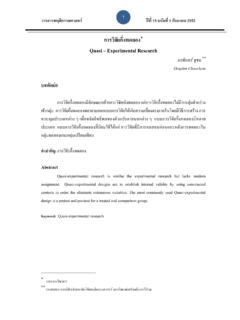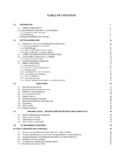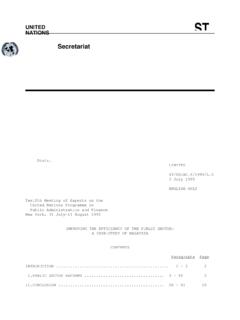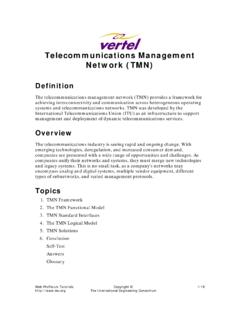Transcription of Training and Development in Telecommunications
1 The 4th International Postgraduate Research Colloquium IPRC Proceedings -125- Training and Development in Telecommunications Nittana Southiseng1 and John Walsh2 Shinawatra University The lack of qualified human resource in both technical and managerial competencies in Lao telecommunication sector make the Lao Government confront with immense constraints in its other Development project expansion. The GoL hence attempts to improve the HR in the telecommunication industry. The Training and Development are the key instruments to build the HR capacity of this industry. The sufficient investment on human capital T&D did and will produce a moderate and positive impacts on employee productivity improvement (Prongjit, 2006, p.)
2 30), and also to the organizational performance Development as a whole (Kraiger, McLinden, & Casper, 2004, p. 337). This research thereby investigated the actual T&D practices of the Lao telecommunication . Four main findings were found such as: The T&D had strong relationship to the telecom organizational performance improvement, the correlation of the Training institute capacity and telecom personnel skills Development is high, the T&D planning process influenced on the employee productivity Development , and the T&D provision associated with the financial condition of the relevant organization. Keywords: Training and Development , personnel Development , Lao telecommunication Training and Development in Telecommunications Sector of Lao People s Democratic Republic Lao People s Democratic Republic (Lao ) is a landlocked country and bordered with five neighboring countries of China, Vietnam, Cambodia, Thailand and Myanmar.
3 Earlier, the telecom operation in Lao was dominated mainly by one player of the Lao Telecom Company or LTC (World Bank [WB], 2007). It especially was executed under the Lao Government (GoL). Since the GoL has opened the door policy for JVs and private investments in telecommunication businesses in 1994, four more telecom operators exists with more than 2,000 employees as a whole (WB, 2007). There are two State-Owned Enterprises (SOEs), two JVs and one private company. Competitively, JVs was positioned as the key player with more than 68 percent market share of the telecom market, in particular in the mobile service market (Souvannvong, 2005).
4 The entire Lao telecommunication is particularly regulated under the Ministry of Communication, Transport, Post and Construction (MCTPC), referred to the Law on telecommunication of Laos (President s Office of Lao People s 1 Candidate 2 Assistant Professor, , School of Management, Shinawatra University, Bangkok, Thailand The 4th International Postgraduate Research Colloquium IPRC Proceedings -126- Democratic Republic [PO Lao ], 2001). Based on the population of 5,609,000 people estimated in 2004, the telecom density was 20 percent per 100 inhabitants or only 1,812,289 telephone capacity lines (1,120,830 using lines), and 42,021 internet capacity lines (4,638 using lines), referred by MCTPC (Ministry of Communication, Transport, Post and Construction [MCTPC], 2006).
5 This inadequate performance was identified and mainly caused by insufficient infrastructure and a shortage of competent telecom personnel (MCTPC). It negatively influenced, in particular, on the effectiveness of distance communication and slowed up the Development projects of the GoL (Enterprise of Telecommunications Lao [ETL], 2002). To strengthen the entire telecom operation performance, the T&D were perceived as proactive approaches that helped develop the technical and conceptual skills of an individual s skills, knowledge and abilities (SKAs), highlighted by Ganolfi (2006). The T&D needs to be a focus for all members of staff including senior managers and junior employees (Anonymous, 2006).
6 However, Spencer (2007) reveals that the T&D possibly lead to Training fatigue in organizing both learners and trainers as it easily becomes unconscious and ineffective (p. 52). Hence, this research attempts to explore the current practice how the T&D have been implemented and managed in the Lao telecom sector; what factors could positively and negatively influence on the T&D results; and to provide recommendations for further research. Methodology of the Study This study particularly applied the qualitative approach because the qualitative consequences adding a holistic illustration and explore deeper into the findings (Prongjit, 2006, p. 35). The qualitative approach focuses on naturally occurrences and ordinary events (Miles & Huberman, 1994), so the research has a strong handle on real life exploration of how the T&D have been implemented and managed in among the telecom operators and other relevant administrative bodies of governmental sector of Laos.
7 The population of this research is among the employees in five telecom operators and department managers in other relevant governmental administration body of the MCTPC, and the Training institutes of the Telecom and Communication Training Institute (TCTI) and the National University of Laos (NUOL). The supporting data got from both secondary data (reports, statistics, research, journals and etc.), and primary data. The sampling design method was non-probability; the interviewees were randomly selected to get in-dept interview by especially using the sampling methods of conveniences, networking and snowballing approaches; which means getting suggestion from one sample to another sample who knows each other.
8 The total samples of the primary data collection consisted of eight face to face personal interviews and four interviews via phone. Each interview took around an hour to share knowledge between the interviewee and interviewer. Four techniques have been engaged such as: closed-ended question, open-ended question, role playing and construction. Before the interviews have been fallen into place, the researcher was asked to submit the official information requesting letter to the targeted organization; in the meantime, the research was also required to have the list of questions which the research expect submitted to that particular The 4th International Postgraduate Research Colloquium IPRC Proceedings -127- organization in advance since they had to initially investigate whether the required information could be served for the academic purpose or not.
9 It is common for the researcher to jot down and have direct observation during the interviews to reduce the bias when the interviewees answered the questions. The interviews were not subjected to any model as the researcher anticipated making the interviews flow naturally to get more concurrent information. Each interview took at least one hour for information exchange. After each interview, the data was immediately processed, reorganized, corrected and analyzed by using the content analysis with anonymity protection for academic purpose before finalizing the complete report. To enhance the reliability and validity of the information interpretation, the data analyzed had been rechecked and corrected in corporation with a highly experienced academic researcher.
10 Four main results were found which are (1) T&D role has relationship with the organizational performance enhancement, (2) telecom personnel skill Development are associated with the capacity of the T&D, (3) T&D planning process in Telecommunications sector of Laos, and (4) T&D has relationship with the financial portfolio of the organization. They are demonstrated and explained in the following paragraphs. Results Relationship between Training and Development and Organizational Performance The T&D became a learning process that involves the acquisition of skills, concepts and organizational rules to enhance the employee s performance. The T&D have commonly been designed as an essential instrument for changing the employees attitudes and behaviors towards the organizational goals.







